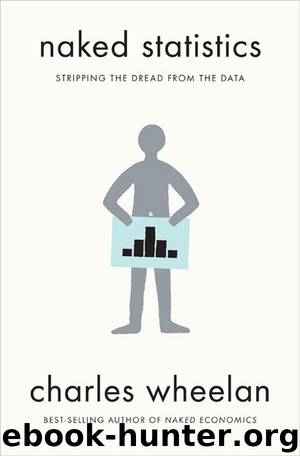Naked Statistics: Stripping the Dread from the Data by Wheelan Charles

Author:Wheelan, Charles [Wheelan, Charles]
Language: eng
Format: epub, mobi
Publisher: Norton
Published: 2013-01-07T00:00:00+00:00
So let’s return to a variation on our lost-bus example, only now we can substitute numbers for intuition. (The example itself will remain absurd; the next chapter will have plenty of less absurd, real-world examples.) Suppose that the Changing Lives study has invited all of the individuals in the study to meet in Boston for a weekend of data gathering and revelry. The participants are loaded randomly onto buses and ferried among the buildings at the testing facility where they are weighed, measured, poked, prodded, and so on. Shockingly, one bus goes missing, a fact that is broadcast on the local news. At around that time, you are driving back from the Festival of Sausage when you see a crashed bus on the side of the road. Apparently the bus swerved to miss a wild fox crossing the road, and all of the passengers are unconscious but not seriously hurt. (I need them to be uncommunicative for the example to work, but I don’t want their injuries to be too disturbing.) Paramedics on the scene inform you that the mean weight of the 62 passengers on the bus is 194 pounds. Also, the fox that the bus swerved to avoid was clipped slightly and appears to have a broken hind leg.
Fortunately you know the mean weight and standard deviation for the entire Changing Lives population, you have a working knowledge of the central limit theorem, and you know how to administer first aid to a wild fox. The mean weight for the Changing Lives participants is 162; the standard deviation is 36. From that information, we can calculate the standard error for a 62-person sample (the number of unconscious passengers on the bus):
The difference between the sample mean (194 pounds) and the population mean (162 pounds) is 32 pounds, or well more than three standard errors. We know from the central limit theorem that 99.7 percent of all sample means will lie within three standard errors of the population mean. That makes it extremely unlikely that this bus represents a random group of Changing Lives participants. In your duty as a civic leader, you call the study officials to tell them that this is probably not their missing bus, only now you can offer statistical evidence, rather than just “a hunch.” You report to the Changing Lives folks that you can reject the possibility that this is the missing bus at the 99.7 percent confidence level. And since you are talking to researchers, they actually understand what you are talking about.
Your analysis is further confirmed when paramedics conduct blood tests on the bus passengers and discover that the mean cholesterol level for the busload of passengers is five standard errors above the mean cholesterol level for the Changing Lives study participants. That suggests, correctly it later turns out, that the unconscious passengers are involved with the Festival of Sausage.
[There is a happy ending. When the bus passengers regained consciousness, Changing Lives study officials offered them counseling on the dangers of a diet high in saturated fats, causing many of them to adopt more heart-healthy eating habits.
Download
Naked Statistics: Stripping the Dread from the Data by Wheelan Charles.mobi
This site does not store any files on its server. We only index and link to content provided by other sites. Please contact the content providers to delete copyright contents if any and email us, we'll remove relevant links or contents immediately.
| Biomathematics | Differential Equations |
| Game Theory | Graph Theory |
| Linear Programming | Probability & Statistics |
| Statistics | Stochastic Modeling |
| Vector Analysis |
Modelling of Convective Heat and Mass Transfer in Rotating Flows by Igor V. Shevchuk(6406)
Weapons of Math Destruction by Cathy O'Neil(6215)
Factfulness: Ten Reasons We're Wrong About the World – and Why Things Are Better Than You Think by Hans Rosling(4713)
A Mind For Numbers: How to Excel at Math and Science (Even If You Flunked Algebra) by Barbara Oakley(3256)
Descartes' Error by Antonio Damasio(3248)
Factfulness_Ten Reasons We're Wrong About the World_and Why Things Are Better Than You Think by Hans Rosling(3216)
TCP IP by Todd Lammle(3154)
Fooled by Randomness: The Hidden Role of Chance in Life and in the Markets by Nassim Nicholas Taleb(3080)
Applied Predictive Modeling by Max Kuhn & Kjell Johnson(3041)
The Tyranny of Metrics by Jerry Z. Muller(3028)
The Book of Numbers by Peter Bentley(2929)
The Great Unknown by Marcus du Sautoy(2662)
Once Upon an Algorithm by Martin Erwig(2622)
Easy Algebra Step-by-Step by Sandra Luna McCune(2604)
Lady Luck by Kristen Ashley(2554)
Police Exams Prep 2018-2019 by Kaplan Test Prep(2516)
Practical Guide To Principal Component Methods in R (Multivariate Analysis Book 2) by Alboukadel Kassambara(2513)
All Things Reconsidered by Bill Thompson III(2371)
Linear Time-Invariant Systems, Behaviors and Modules by Ulrich Oberst & Martin Scheicher & Ingrid Scheicher(2346)
